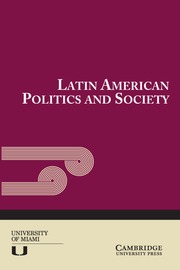Crossref Citations
This article has been cited by the following publications. This list is generated based on data provided by
Crossref.
Wolford, Wendy
2007.
Land Reform in the Time of Neoliberalism: A Many‐Splendored Thing.
Antipode,
Vol. 39,
Issue. 3,
p.
550.
Ondetti, Gabriel
2008.
Up and Down with the Agrarian Question:
Issue Attention and Land Reform in Contemporary Brazil.
Politics & Policy,
Vol. 36,
Issue. 4,
p.
510.
Shekha, K. Russell
2011.
Determinants of Latin American Activism: Domestic and Transnational Political Opportunities and Threats.
Sociology Compass,
Vol. 5,
Issue. 8,
p.
747.
Fu, Diana
2017.
Fragmented control: Governing contentious labor organizations in China.
Governance,
Vol. 30,
Issue. 3,
p.
445.
Girod, Desha M
Stewart, Megan A
and
Walters, Meir R
2018.
Mass protests and the resource curse: The politics of demobilization in rentier autocracies.
Conflict Management and Peace Science,
Vol. 35,
Issue. 5,
p.
503.
Odabaş, Meltem
and
Reynolds-Stenson, Heidi
2018.
Tweeting from Gezi Park: Social Media and Repression Backfire.
Social Currents,
Vol. 5,
Issue. 4,
p.
386.
Loera, Nashieli Rangel
2019.
De movimientos, botellas y consideración: la producción cotidiana de lo común en asentamientos rurales del estado de São Paulo, Brasil.
Revista de Estudios Sociales,
p.
37.
Wilson Becerril, Michael S.
2019.
Civil Resistance and Violent Conflict in Latin America.
p.
175.
Kadivar, Mohammad Ali
Usmani, Adaner
and
Bradlow, Benjamin H
2019.
The Long March: Deep Democracy in Cross-National Perspective.
Social Forces,
Pahnke, Anthony
2020.
Social Movement Consolidation and Strategic Shifts: The Brazilian Landless Movement during the Lula and Dilma Administrations.
Latin American Perspectives,
Vol. 47,
Issue. 4,
p.
206.
Etchemendy, Sebastián
2020.
The Politics of Popular Coalitions: Unions and Territorial Social Movements in Post-Neoliberal Latin America (2000–15).
Journal of Latin American Studies,
Vol. 52,
Issue. 1,
p.
157.
Sika, Nadine
2020.
Contentious activism and political trust in non-democratic regimes: evidence from the MENA.
Democratization,
Vol. 27,
Issue. 8,
p.
1515.
Kapiszewski, Diana
Levitsky, Steven
and
Yashar, Deborah J.
2021.
The Inclusionary Turn in Latin American Democracies.
Wilson, Sophia
2021.
Four Dead in Ohio.
p.
157.
Etchemendy, Sebastián
2021.
The Inclusionary Turn in Latin American Democracies.
p.
287.
2021.
The Inclusionary Turn in Latin American Democracies.
p.
285.
Albert, Victor
2021.
Occupying Paulista: Housing activism, the new right and the politics of public space during the Brazilian crisis.
Thesis Eleven,
Vol. 164,
Issue. 1,
p.
37.
Mangulama, Justin Alinafe
and
Wu, Jin
2022.
Capital Penetration and the Peasantry in Southern and Eastern Africa.
p.
101.
Soto, Oscar
and
Martin, Facundo
2023.
Neoliberalism in rural South America: political trends in peasant-led unionization (2000–2020).
Canadian Journal of Development Studies / Revue canadienne d'études du développement,
Vol. 44,
Issue. 1,
p.
77.
Simbsler, David
2023.
Témoigner de la lutte ?.
Ethnologie française,
Vol. Vol. 53,
Issue. 2,
p.
211.




